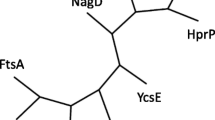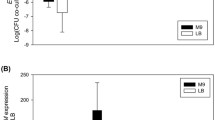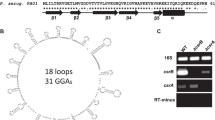Abstract
In Erwinia amylovora, the Rcs phosphorelay system is essential for amylovoran production and virulence. To further understand the role of conserved aspartate residue (D56) in the phosphor receiver (PR) domain and lysine (K180) residue in the function domain of RcsB, amino acid substitutions of RcsB mutant alleles were generated by site-directed mutagenesis and complementation of various rcs mutants were performed. A D56E substitution of RcsB, which mimics the phosphorylation state of RcsB, complemented the rcsB mutant, resulting in increased amylovoran production and gene expression, reduced swarming motility, and restored pathogenicity. In contrast, D56N and K180A or K180Q substitutions of RcsB did not complement the rcsB mutant. Electrophoresis mobility shift assays showed that D56E, but not D56N, K180Q and K180A substitutions of RcsB bound to promoters of amsG and flhD, indicating that both D56 and K180 are required for DNA binding. Interestingly, the RcsBD56E allele could also complement rcsAB, rcsBC and rcsABCD mutants with restored virulence and increased amylovoran production, indicating that RcsB phosphorylation is essential for virulence of E. amylovora. In addition, mutations of T904 and A905, but not phosphorylation mimic mutation of D876 in the PR domain of RcsC, constitutively activate the Rcs system, suggesting that phosphor transfer is required for activating the Rcs system and indicating both A905 and T904 are required for the phosphatase activity of RcsC. Our results demonstrated that RcsB phosphorylation and dephosphorylation, phosphor transfer from RcsC are essential for the function of the Rcs system, and also suggested that constitutive activation of the Rcs system could reduce the fitness of E. amylovora.






Similar content being viewed by others
References
Ancona V, Li W, Zhao Y (2014) Alternative sigma factor RpoN and its modulator protein YhbH are indispensable for Erwinia amylovora virulence. Mol Plant Pathol 15:58–66
Andresen L, Sala E, Kõiv V, Mäe A (2010) A role for the Rcs phosphorelay in regulating expression of plant cell wall degrading enzymes in Pectobacterium carotovorum subsp. carotovorum. Microbiology 156:1323–1334
Bellemann P, Geider K (1992) Localization of transposon insertions in pathogenicity mutants of Erwinia amylovora and their biochemical characterization. J Gen Microbiol 138:931–940
Bellemann P, Bereswill S, Berger S, Geider K (1994) Visualization of capsule formation by Erwinia amylovora and assays to determine amylovoran synthesis. Int J Biol Macromol 16:290–296
Bereswill S, Geider K (1997) Characterization of the rcsB gene from Erwinia amylovora and its influence on exoploysaccharide synthesis and virulence of the fire blight pathogen. J Bacteriol 179:1354–1361
Bernhard F, Poetter K, Geider K, Coplin DL (1990) The rcsA gene from Erwinia amylovora: identification, nucleotide sequence, and regulation of exopolysaccharide biosynthesis. Mol Plant Microbe Interact 3:429–437
Bernhard F, Coplin DL, Geider K (1993) A gene cluster for amylovoran synthesis in Erwinia amylovora: characterization and relationship to cps genes in Erwinia stewartii. Mol Gen Genet 239:158–168
Brill JA, Quinlan-Walshe C, Gottesman S (1988) Fine-structure mapping and identification of two regulators of capsule synthesis in Escherichia coli K-12. J Bacteriol 170:2599–2611
Castelli ME, Garcia Vescovi E (2011) The Rcs signal transduction pathway is triggered by enterobacterial common antigen structure alterations in Serratia marcescens. J Bacteriol 193:63–74
Clarke DJ (2010) The Rcs phosphorelay: more than just a two-component pathway. Futur Microbiol 5:1173–1184
Clarke DJ, Joyce SA, Toutain CM, Jacq A, Holland IB (2002) Genetic analysis of the RcsC sensor kinase from Escherichia coli K-12. J Bacteriol 184:1204–1208
Datsenko KA, Wanner BL (2000) One-step inactivation of chromosomal genes in Escherichia coli K-12 using PCR products. Proc Natl Acad Sci USA 97:6640–6645
Erickson KD, Detweiler CS (2006) The Rcs phosphorelay system is specific to enteric pathogens/commensals and activates ydeI, a gene important for persistent Salmonella infection of mice. Mol Microbiol 62:883–894
Ferrieres L, Clarke DJ (2003) The RcsC sensor kinase is required for normal biofilm formation in Escherichia coli K-12 and controls the expression of a regulon in response to growth on a solid surface. Mol Microbiol 50:1665–1682
Francez-Charlot A, Laugel B, Van Gemert A, Dubarry N, Wiorowski F, Castanié-Cornet M-P, Gutierrez C, Cam K (2003) RcsCDB His-Asp phosphorelay system negatively regulates the flhDC operon in Escherichia coli. Mol Microbiol 49:823–832
Fredericks CE, Shibata S, Aizawa S-I, Reimann SA, Wolfe AJ (2006) Acetyl phosphate-sensitive regulation of flagellar biogenesis and capsular biosynthesis depends on the Rcs phosphorelay. Mol Microbiol 61:734–747
García-Calderón CB, Casadesús J, Ramos-Morales F (2007) Rcs and PhoPQ regulatory overlap in the control of Salmonella enterica virulence. J Bacteriol 189:6635–6644
Gottesman S, Trisler P, Torres-Cabassa A (1985) Regulation of capsular polysaccharide synthesis in Escherichia coli K-12: characterization of three regulatory genes. J Bacteriol 162:1111–1119
Hildebrand M, Aldridge P, Geider K (2006) Characterization of hns genes from Erwinia amylovora. Mol Genet Genomics 275:310–319
Hinchliffe SJ, Howard SL, Huang YH, Clarke DJ, Wren BW (2008) The importance of the Rcs phosphorelay in the survival and pathogenesis of the enteropathogenic yersiniae. Microbiology 154:1117–1131
Hu LI, Chi BK, Kuhn ML, Filippova EV, Walker-Peddakotla AJ, Bäsell K, Becher D, Anderson WF, Antelmann H, Wolfe AJ (2013) Acetylation of the response regulator RcsB controls transcription from a small RNA promoter. J Bacteriol 195:4174–4186
Huang Y-H, Ferrières L, Clarke DJ (2006) The role of the Rcs phosphorelay in Enterobacteriaceae. Res Microbiol 157:206–212
Kelm O, Kiecker C, Geider K, Bernhard F (1997) Interaction of the regulator proteins RcsA and RcsB with the promoter of the operon for amylovoran biosynthesis in Erwinia amylovora. Mol Gen Genet 256:72–83
Khan MA, Zhao YF, Korban SS (2012) Molecular mechanisms of pathogenesis and resistance to the bacterial pathogen Erwinia amylovora, causal agent of fire blight disease in Rosaceae. Plant Mol Biol Rep 30:247–260
Koczan JM, McGrath MJ, Zhao YF, Sundin GW (2009) Contribution of Erwinia amylovora exopolysaccharides amylovoran and levan to biofilm formation: implications in pathogenicity. Phytopathology 99:1237–1244
Krin E, Danchin A, Soutourina O (2010) RcsB plays a central role in H-NS-dependent regulation of motility and acid stress resistance in Escherichia coli. Res Microbiol 161:363–371
Latasa C, García B, Echeverz M, Toledo-Arana A, Valle J, Campoy S, García-del Portillo F, Solano C, Lasa I (2012) Salmonella biofilm development depends on the phosphorylation status of RcsB. J Bacteriol 194:3708–3722
Lehti TA, Heikkinen J, Korhonen TK, Westerlund-Wikström B (2012) The response regulator RcsB activates expression of Mat fimbriae in meningitic Escherichia coli. J Bacteriol 194:3475–3485
Li W, Anocona V, Zhao YF (2014) Co-regulation of polysaccharide production, motility, and expression of type III secretion genes by EnvZ/OmpR and GrrS/GrrA systems in Erwinia amylovora. Mol Gen Genomics 289:63–75
Majdalani N, Gottesman S (2005) The Rcs phosphorelay: a complex signal transduction system. Annu Rev Microbiol 59:379–405
Majdalani N, Heck M, Stout V, Gottesman S (2005) Role of RcsF in signaling to the Rcs phosphorelay pathway in Escherichia coli. J Bacteriol 187:6770–6778
Nimtz M, Mort A, Domke T, Wray V, Zhang Y, Qiu F, Coplin D, Geider K (1996) Structure of amylovoran, the capsular exopolysaccharide from the fire blight pathogen Erwinia amylovora. Carbohydr Res 287:59–76
Oh C-S, Beer SV (2005) Molecular genetics of Erwinia amylovora involved in the development of fire blight. Fed Eur Microbiol Soc Lett 253:185–192
Pristovsek P, Sengupta K, Löhr F, Schäfer B, von Trebra MW, Rüterjans H, Bernhard F (2003) Structural analysis of the DNA-binding domain of the Erwinia amylovora RcsB protein and its interaction with the RcsAB box. J Biol Chem 278:17752–17759
Rocco CJ, Dennison KL, Klenchin VA, Rayment I, Escalante-Semerena JC (2008) Construction and use of new cloning vectors for the rapid isolation of recombinant proteins from Escherichia coli. Plasmid 59:231–237
Rogov VV, Bernhard F, Lohr F, Dotsch V (2004) Solution structure of the Escherichia coli YojN histidine-phosphotransferase domain and its interaction with cognate phosphoryl receiver domains. J Mol Biol 343:1035–1048
Rogov VV, Rogov NY, Bernhard F, Koglin A, Lohr F, Dotsch V (2006) A new structural domain in the Escherichia coli RcsC hybrid sensor kinase connects histidine kinase and phosphoreceiver domains. J Mol Biol 364:68–79
Schmoe K, Rogov VV, Yu N, Lohr F, Guntert P, Bernhard F, Dotsch V (2011) Structural insights into Rcs phosphotransfer: the newly identified RcsD-ABL domain enhances interaction with the response regulator RcsB. Structure 19:577–587
Thao S, Chen C-S, Zhu H, Escalante-Semerena JC (2010) Nε-lysine acetylation of a bacterial transcription factor inhibits its DNA-binding activity. PLoS One 5:e15123
Venkatesh GR, Kembou Koungni FC, Paukner A, Stratmann T, Blissenbach B, Schnetz K (2010) BglJ–RcsB heterodimers relieve repression of the Escherichia coli bgl operon by H-NS. J Bacteriol 192:6456–6464
Wang RF, Kushner SR (1991) Construction of versatile low-copy-number vectors for cloning, sequencing and gene expression in Escherichia coli. Gene 100:195–199
Wang Q, Zhao Y, McClelland M, Harshey RM (2007) The RcsCDB signaling system and swarming motility in Salmonella enterica serovar typhimurium: dual regulation of flagellar and SPI-2 virulence genes. J Bacteriol 189:8447–8457
Wang D, Korban SS, Zhao Y (2009) The Rcs phosphorelay system is essential for pathogenicity in Erwinia amylovora. Mol Plant Pathol 10:277–290
Wang D, Korban SS, Pusey PL, Zhao Y (2011) Characterization of the RcsC sensor kinase from Erwinia amylovora and other Enterobacteria. Phytopathology 101:710–717
Wang D, Qi M, Calla B, Korban SS, Clough SJ, Cock PJA, Sundin GW, Toth I, Zhao Y (2012) Genome-wide identification of genes regulated by the Rcs phosphorelay system in Erwinia amylovora. Mol Plant Microbe Interact 25:6–17
Wehland M, Bernhard F (2000) The RcsAB box. Characterization of a new operator essential for the regulation of exopolysaccharide biosynthesis in enteric bacteria. J Biol Chem 275:7013–7020
Wehland M, Kiecker C, Coplin DL, Kelm O, Saenger W, Bernhard F (1999) Identification of an RcsA/RcsB recognition motif in the promoters of exopolysaccharide biosynthetic operons from Erwinia amylovora and Pantoea stewartii subspecies stewartii. J Biol Chem 274:3300–3307
Zhao YF (2014) Genomics of Erwinia amylovora and related species associated with pome fruit trees. In Gross et al. (eds), “Genomics of plant-associated bacteria”. Springer, pp1–36
Zhao YF, Qi M (2011) Comparative Genomics of Erwinia amylovora and related Erwinia Species—What do We Learn? Genes 2:627–639
Zhao Y, Sundin GW, Wang D (2009a) Construction and analysis of pathogenicity island deletion mutants of Erwinia amylovora. Can J Microbiol 55:457–464
Zhao Y, Wang D, Nakka S, Sundin GW, Korban SS (2009b) Systems level analysis of two-component signal transduction systems in Erwinia amylovora: role in virulence, regulation of amylovoran biosynthesis and swarming motility. BMC Genom 10:245
Acknowledgments
We thank Dr. Jorge Escalante, University of Georgia, for providing plasmids. This project was supported by the Agriculture and Food Research Initiative Competitive Grants Program Grant no. 2010-65110-20497 from the USDA National Institute of Food and Agriculture and USDA-Hatch Project ILLU-802-913 (YFZ).
Author information
Authors and Affiliations
Corresponding author
Additional information
Communicated by A.M. Hirsch.
Electronic supplementary material
Below is the link to the electronic supplementary material.
Rights and permissions
About this article
Cite this article
Ancona, V., Chatnaparat, T. & Zhao, Y. Conserved aspartate and lysine residues of RcsB are required for amylovoran biosynthesis, virulence, and DNA binding in Erwinia amylovora . Mol Genet Genomics 290, 1265–1276 (2015). https://doi.org/10.1007/s00438-015-0988-8
Received:
Accepted:
Published:
Issue Date:
DOI: https://doi.org/10.1007/s00438-015-0988-8




